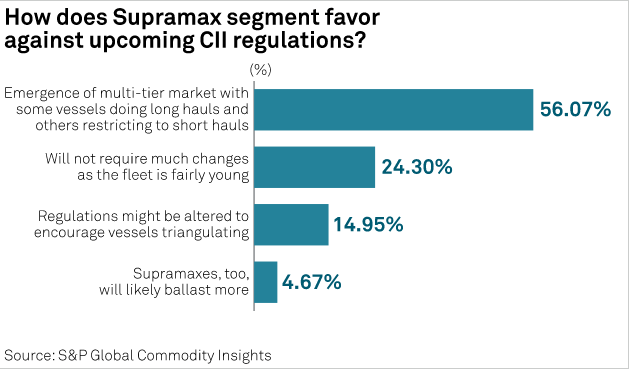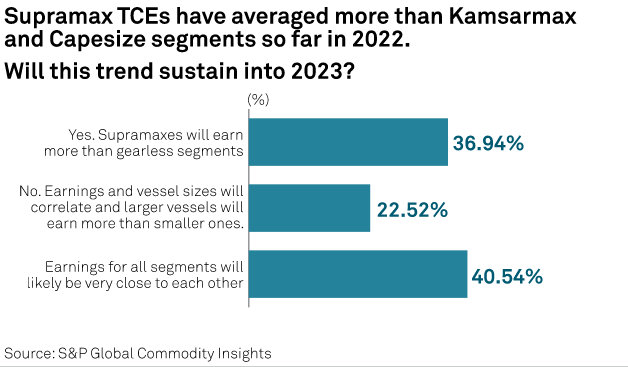Stormy seas lie ahead for the dry bulk market as the shipping industry comes to terms with the new environmental regulations being introduced by the International Maritime Organization in 2023, a survey by S&P Global Commodity Insights has found.
The new regulatory requirements such as the Energy Efficiency Existing Ship Index, or EEXI, and Carbon Intensity Indicator, or CII, are expected to create a multi-tier market based on ships’ ratings, fuel choices and performance.
The economic slowdown being faced by the world’s largest commodity consumer China is also weighing on the dry bulk freight market, along with the demand squeeze being seen in key dry bulk commodities that is impacting the earnings of bulkers across all sizes.
The survey has shown that the earnings in bulker sectors across Capesize, Kamsarmax/Panamax and Ultramax/Supramax may average around the same levels next year as in 2022 due to the subdued economic climate on the back of high interest rates and slow growth.
New regulation may forge multi-tiered market
The upcoming emission-related regulations are expected to create a multi-tier spot market for Supramax class bulkers, according to 56% of survey respondents.

It will be slightly different situation for the Capesize and Panamax ships, which tend to have longer ballast leg sailings than Supramaxess, which help them draw better environmental ratings based on the CII parameters.
“There has already been a two-tier market in the dry bulk segment for some time,” said maritime research consultancy Drewry’s Director-Deputy Head Maritime Advisors Jayendu Krishna.
“First, it was for eco- and non-eco vessels. That was followed by scrubber and non-scrubber vessels under high bunker price environment. Going forward, it will be for fuel oil-propelled single-fuel vessels versus dual-fuel vessels,” he added.
It could also result in a category of ships that could trade anywhere in the world, while others would be restricted to certain regions.
“However, the number of ships in those two categories will likely fluctuate and ships could jump between these groups,” said a shipbroker source, adding that the market has become convoluted in recent years.
According to a shipping executive with a mining major, charterers may not pay different voyage freight rates depending on the fuel used or the efficiency of the ship unless they have to. “I don’t think this could change at least until 2025,” the executive added.
A multi-tier market could pose many challenges for freight traders and market analysts as it would blur the ability to gauge market trends in the event of less liquidity within a specific tier, said Marc Pauchet, Director, Dry Bulk Research, at Maersk Broker.
Grim outlook may keep bulker earnings at parity
A volatile spot dry bulk market can be expected next year, with 40.54% of survey respondents saying they expect the earnings of all dry bulk segments to stay at levels close to each other in 2023.
Less than a quarter (22.52%) of participants expected vessel sizes and earnings would correlate, while 36.94% said the Supramax sector could continue to earn more than gearless vessels next year.

“If the overall dry bulk market is poor and stays close to operating expenses, which is what I expect for next year, then the contrast in time charter earnings won’t be much different across various segments of bulkers,” said the shipping executive with a mining major.
“But Supramax rates could increase if there is a ceasefire in Ukraine and there is reconstruction work,” the source added.
Some shipping industry watchers say commodities’ “love story with China” has come to an end, which has visibly impacted larger Capesize segment and to an extent the Panamax sector.
“Commodities like iron ore, aluminum and copper that have a large exposure to China have underperformed and impacted the Capesize freight rates,” said Rishi Nyati, Managing Director at Emarat Maritime.
“In the long-term, there is little doubt that China has peaked. Not too different from Japan in the late 1980s. Therefore, I feel commodities that are highly exposed to China will suffer in the long term,” Nyati added.
Over 2021-2022, high container rates have benefited the Supramax sector due to the de-containerization of cargoes. “But I believe the support Supramaxes saw from containerized cargoes is finished for the foreseeable future,” a shipping executive said.
There were also expectations among survey participants that the Ultramax and Supramax segments would continue to outperform the larger Panamax segment due to a drop in the movement of coal on the latter.
“China is importing less coal, while the surge in Europe has already taken place this year, and India’s [coal] demand will not be enough to compensate,” Pauchet said.
“I think the earnings of Handysizes, Supramaxes and Panamaxes will most likely be quite tight indeed, but I can’t see Capesizes re-correlating with the other three segments; they will carry on having a life of their own,” he added.
Some other market participants disagree, saying there will be times when the Capesizes may earn less than Supramaxes and Ultramaxes.
“But overall, I don’t think Supramaxes can average higher than Capesizes over the next year,” the shipbroker said.
Source: Platts
The opinions expressed herein are the author's and not necessarily those of The Xinde Marine News.
Please Contact Us at:
media@xindemarine.com



 Ningbo Containerized Freight Index Weekly Commentar
Ningbo Containerized Freight Index Weekly Commentar  Ningbo Containerized Freight Index Weekly Commentar
Ningbo Containerized Freight Index Weekly Commentar  Ningbo Containerized Freight Index Weekly Commentar
Ningbo Containerized Freight Index Weekly Commentar  BIMCO Shipping Number of the Week: Bulker newbuildi
BIMCO Shipping Number of the Week: Bulker newbuildi  Ningbo Containerized Freight Index Weekly Commentar
Ningbo Containerized Freight Index Weekly Commentar  Ningbo Containerized Freight Index Weekly Commentar
Ningbo Containerized Freight Index Weekly Commentar